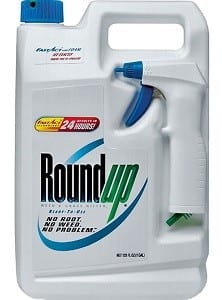 A Virginia man has filed a Monsanto lawsuit in Missouri after developing a rare form of non-Hodgkin’s lymphoma. His lawsuit petition alleges that his cancer was caused by Monsanto’s weedkiller Roundup. The man developed splenic marginal zone lymphoma – which attacks the spleen and bone marrow – after long exposure to Monsanto’s Roundup weed killer.
A Virginia man has filed a Monsanto lawsuit in Missouri after developing a rare form of non-Hodgkin’s lymphoma. His lawsuit petition alleges that his cancer was caused by Monsanto’s weedkiller Roundup. The man developed splenic marginal zone lymphoma – which attacks the spleen and bone marrow – after long exposure to Monsanto’s Roundup weed killer.Related: Monsanto Lawsuit | Lawyer
Michael Dowling filed a product liability lawsuit against Monsanto in the U.S. District Court for the Eastern District of Missouri in December 2016. Mr. Dowling alleges Monsanto failed to adequately warn about risks associated with exposure to glyphosate and surfactant polyethoxylated tallow amine (POEA), a Roundup ingredient.
Mr. Dowling’s petition states that he began using Roundup in the mid-1980s. He sprayed the weedkiller on a regular and consistent basis for many years before being diagnosed with non-Hodgkins lymphoma.
Splenic Marginal Zone Lymphoma
Splenic marginal zone lymphoma, a type of B-cell lymphoma associated with Roundup exposure, is extremely rare. It accounts for about 1% of all cases of non-Hodgkins lymphoma. If the cancer is limited to the spleen, it can sometimes be successfully sent into remission through spleen excision. Without removing the spleen, it can sometimes be successfully treated through a cancer drug called Rituxan.
WHO declares Glyphosate a Probable Carcinogen
According to his petition, Mr. Dowling was unaware of the link between Roundup and cancer until last year, when the World Health Organization’s International Agency for Research on Cancer (IARC) determined that glyphosate in Roundup likely causes cancer. The IARC report linked Roundup with an increased risk of non-Hodgkins lymphoma.
Roundup Lawsuits Grow
Mr. Dowling’s case joins a growing list of Roundup lawsuits filed against Monsanto by farmers, landscapers, agricultural workers and others exposed to Roundup throughout the country. Each plaintiff raises similar allegations. All indicate their various forms of non-Hodgkin’s lymphoma (NHL) were caused by Monsanto’s reckless promotion of carcinogenic Roundup. Monsanto’s blitzkreig promotions pushed more and more Roundup saturation without disclosure of the potential health risks. Monsanto is also charged in the petitions with providing insufficient safety instructions to minimize exposure.
Monsanto Response
Monsanto has denied that there is a link between Roundup and lymphona. The company has called the IARC’s findings “junk science,” which is exactly what many critics of Monsanto call the pesticide maker’s own research into the toxic effects of Roundup and Monsanto’s genetically modified organisms and seed programs.
Roundup Lymphoma Lawsuit Filed
Mr. Dowling’s lawsuit states:
“[S]cientific evidence has established a clear association between glyphosate and genotoxicity, inflammation, and an increased risk of many cancers, including, but not limited to, NHL, Multiple Myeloma, and soft tissue sarcoma. Despite the IARC’s classification of glyphosate as a class 2A probable carcinogen, Defendant continues to maintain that glyphosate and/or Roundup is safe, noncarcinogenic, non-genotoxic, and falsely warrants to users and the general public that independent experts and regulatory agencies agree that there is no evidence of carcinogenicity or genotoxicity in glyphosate and Roundup.”
Roundup Poisons All
A recent U.S. Geological Survey on glyphosate used nationwide found some 2.6 billion pounds of the herbicide has been sprayed on American land since the mid-1990s, when Monsanto first produced “Roundup Ready” crops. These crops are engineered to survive glyphosate spraying, which is meant to kill only the weeds but not the crops. Of course it also kills pollinators and birds and other bright and necessary creatures, along with human gut microbes which humans require in order to remain healthy. (Though that’s not what this lawsuit is about.)
Monsanto Failed to Warn
Monsanto “failed to warn” is the charge in every Monsanto lawsuit. Roundup lawsuit plaintiffs all allege that they might have avoided being diagnosed with non-Hodgkin’s lymphoma or other cancers if they had been warned about Roundup risks for farmers, landscapers and other agricultural industry workers. Had they been properly warned, they could have taken safety precautions or used other products or methods to manage weeds.
Roundup Lawsuits Consolidated in California
Mr. Dowling’s lawsuit will be consolidated with all the other Roundup cases pending in the federal court system. They are now all centralized before U.S. District Judge Vince Chhabria in the Northern District of California, for coordinated discovery and pretrial proceedings. After coordinated proceedings, if parties don’t reach Roundup settlements or some other resolution, each separate complaint may be remanded back to the federal courts where they were originally filed.
RELATED
- Monsanto Lawsuit
- Roundup Cancer Lawsuit
- Glypohosate poisons Cereal
- Roundup more toxic than Glyphoate
- Glyphosate contaminates California Wine

by Matthews & Associates




